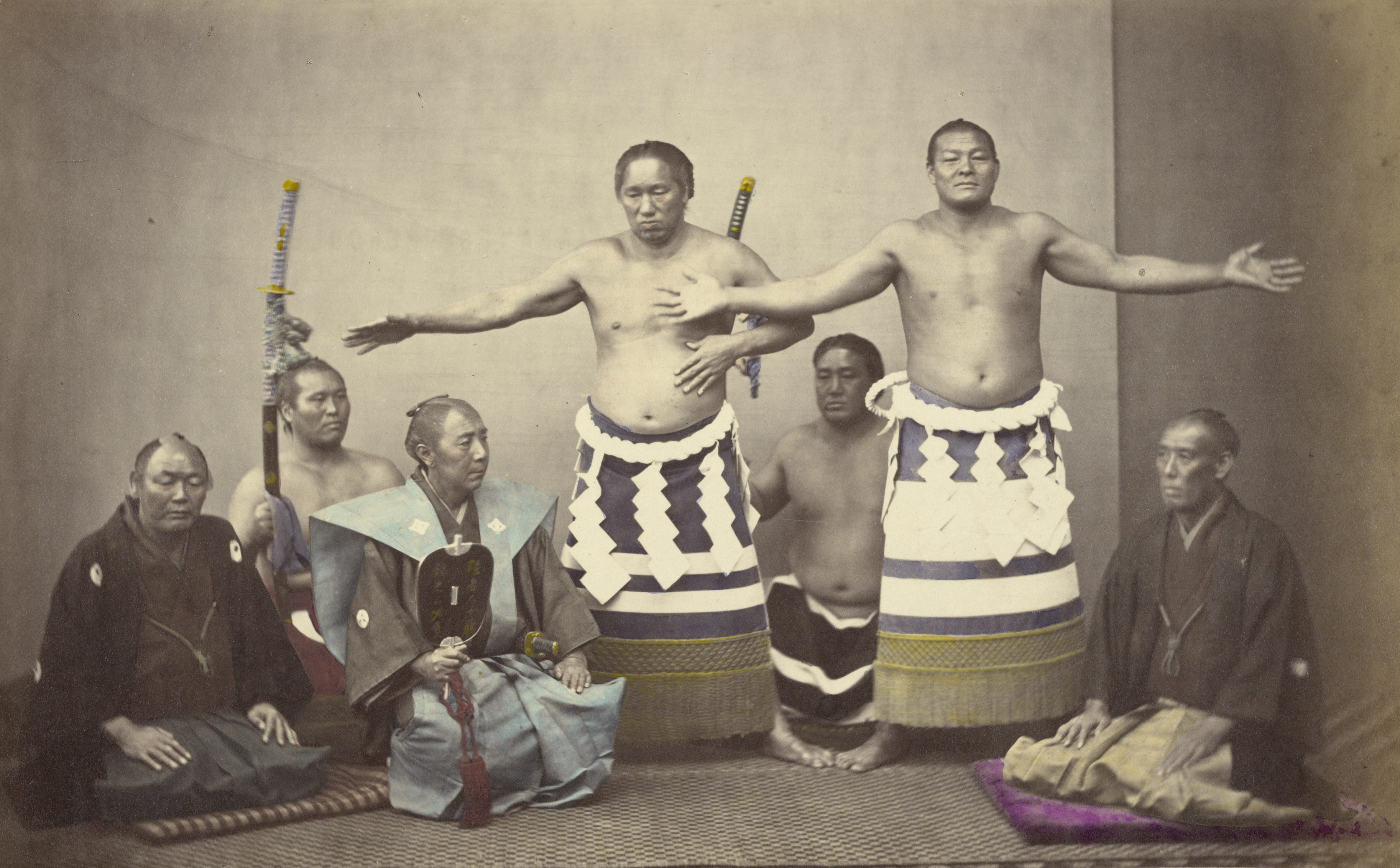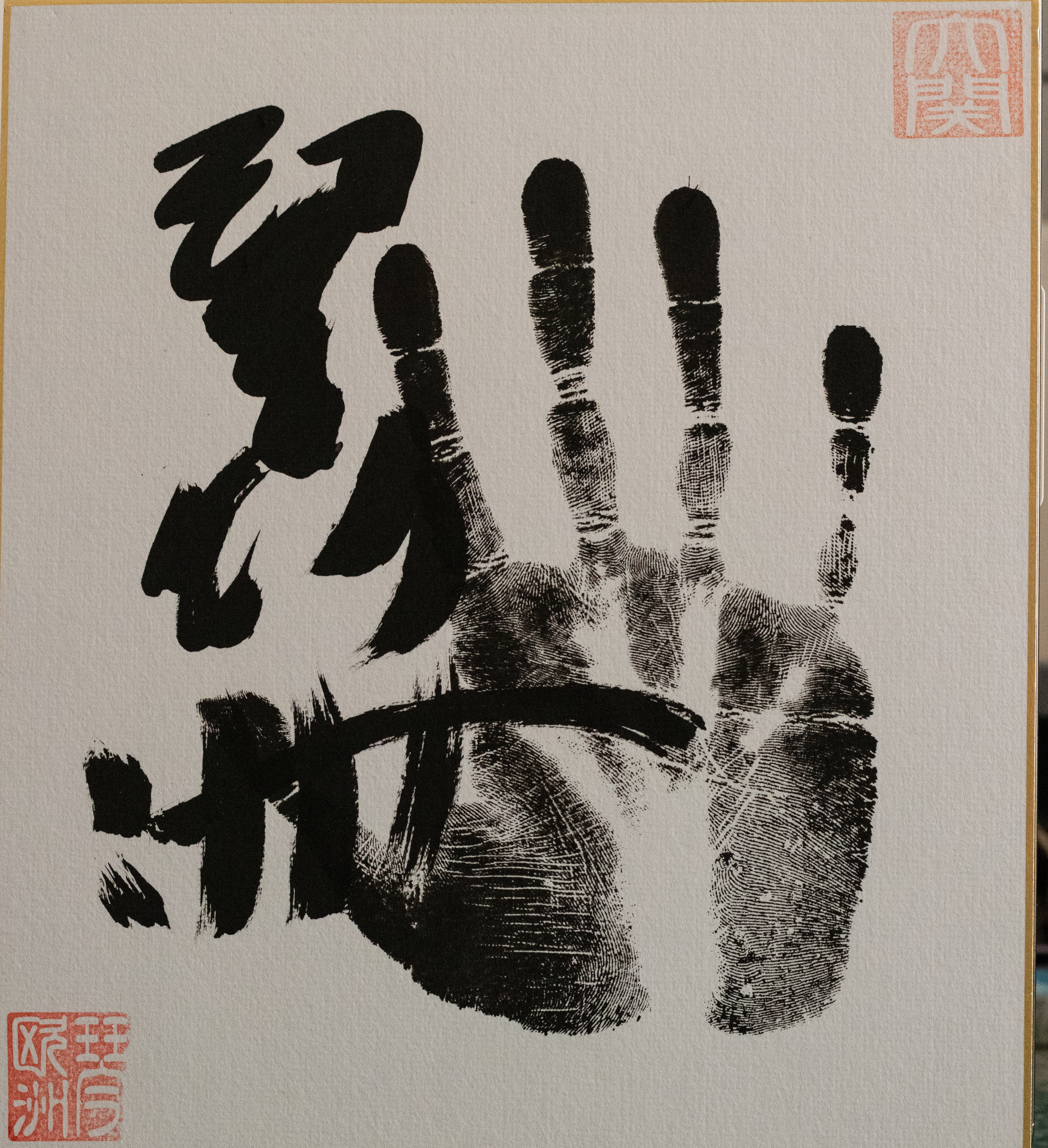|
Mawashi
In sumo, a is the loincloth that (sumo wrestlers) wear during training or in competition. Upper ranked professional wrestlers wear a as part of the ring entry ceremony or . For top ranked professional , it is made of silk and comes in a variety of colours. It is approximately in length when unwrapped, about wide and weighs about . It is wrapped several times around the and fastened in the back by a large knot. A series of stiffened silk fronds of matching colour called are inserted into the front of the . Their number varies from 13 to 25, and is always an odd number. They mark out the only part of the that it is illegal to grab on to: the vertical part covering the 's groin, and if they fall out during competition the (referee) will throw them from the ring at the first opportunity. Sometimes a may wear his in such a way as to give him some advantage over his opponent. He may wear it loosely to make it more difficult to be thrown, or he may wrap it tightly and spl ... [...More Info...] [...Related Items...] OR: [Wikipedia] [Google] [Baidu] |
Glossary Of Sumo Terms
The following words are terms used in sumo wrestling in Japan. A B C D E F G H I J K M N O R S T W Y Z References External links Glossary of Sumo TermsSumopediaat NHK World-Japan {{Glossaries of sports Sumo is a form of competitive full-contact wrestling where a '' rikishi' ... [...More Info...] [...Related Items...] OR: [Wikipedia] [Google] [Baidu] |
Sumo
is a form of competitive full-contact wrestling where a '' rikishi'' (wrestler) attempts to force his opponent out of a circular ring ('' dohyō'') or into touching the ground with any body part other than the soles of his feet (usually by throwing, shoving or pushing him down). Sumo originated in Japan, the only country where it is practiced professionally and where it is considered the national sport. It is considered a '' gendai budō'', which refers to modern Japanese martial arts, but the sport has a history spanning many centuries. Many ancient traditions have been preserved in sumo, and even today the sport includes many ritual elements, such as the use of salt purification, from Shinto. Life as a wrestler is highly regimented, with rules regulated by the Japan Sumo Association. Most sumo wrestlers are required to live in communal sumo training stables, known in Japanese as '' heya'', where all aspects of their daily lives—from meals to their manner of dress— ... [...More Info...] [...Related Items...] OR: [Wikipedia] [Google] [Baidu] |
Makuuchi
, or , is the top division of the six divisions of professional sumo. Its size is fixed at 42 wrestlers ('' rikishi''), ordered into five ranks according to their ability as defined by their performance in previous tournaments. This is the only division that is featured on NHK's standard live coverage of sumo tournaments. The lower divisions are shown on their satellite coverage, with only the ''makuuchi'' broadcast having bilingual English commentary. ''Makuuchi'' literally means "inside the curtain", a reference to the early period of professional sumo, when there was a curtained-off area reserved for the top ranked wrestlers, to sit before appearing for their bouts. Wrestlers are considered for promotion or demotion in rank before each grand tournament according to their performance in the one previous. Generally, a greater number of wins than losses ('' kachi-koshi'') results in a promotion, and the reverse ('' make-koshi'') results in demotion. There are stricter crit ... [...More Info...] [...Related Items...] OR: [Wikipedia] [Google] [Baidu] |
Yokozuna (sumo)
, or , is the top division of the six divisions of professional sumo. Its size is fixed at 42 wrestlers (''rikishi''), ordered into five ranks according to their ability as defined by their performance in previous tournaments. This is the only division that is featured on NHK's standard live coverage of sumo tournaments. The lower divisions are shown on their satellite coverage, with only the ''makuuchi'' broadcast having bilingual English commentary. ''Makuuchi'' literally means "inside the curtain", a reference to the early period of professional sumo, when there was a curtained-off area reserved for the top ranked wrestlers, to sit before appearing for their bouts. Wrestlers are considered for promotion or demotion in rank before each grand tournament according to their performance in the one previous. Generally, a greater number of wins than losses (''kachi-koshi'') results in a promotion, and the reverse (''make-koshi'') results in demotion. There are stricter criteri ... [...More Info...] [...Related Items...] OR: [Wikipedia] [Google] [Baidu] |
Makuuchi
, or , is the top division of the six divisions of professional sumo. Its size is fixed at 42 wrestlers ('' rikishi''), ordered into five ranks according to their ability as defined by their performance in previous tournaments. This is the only division that is featured on NHK's standard live coverage of sumo tournaments. The lower divisions are shown on their satellite coverage, with only the ''makuuchi'' broadcast having bilingual English commentary. ''Makuuchi'' literally means "inside the curtain", a reference to the early period of professional sumo, when there was a curtained-off area reserved for the top ranked wrestlers, to sit before appearing for their bouts. Wrestlers are considered for promotion or demotion in rank before each grand tournament according to their performance in the one previous. Generally, a greater number of wins than losses ('' kachi-koshi'') results in a promotion, and the reverse ('' make-koshi'') results in demotion. There are stricter crit ... [...More Info...] [...Related Items...] OR: [Wikipedia] [Google] [Baidu] |
Sekitori
A ''sekitori'' (関取) is a '' rikishi'' (力士, sumo wrestler) who is ranked in one of the top two professional divisions: '' makuuchi'' and '' jūryō''. The name literally translates to having taken the barrier, as only a relatively small fraction of those who enter professional sumo achieve ''sekitori'' status. Currently there are 70 ''rikishi'' in these divisions. The benefits of being a ''sekitori'' compared to lower ranked wrestlers are significant and include: * to receive a salary and bonus (those in the lower divisions merely receive an allowance) * to have one's own supporters' club * to wear high quality men's kimono and other items of attire * to have a private room in the training stable * to be able to get married and live away from the training stable * to have junior ''rikishi'' to effectively act as their personal servants * to wear a silk '' mawashi'' with stiffened cords (called ''sagari'') in tournament bouts * to participate in the ring entrance ceremony ... [...More Info...] [...Related Items...] OR: [Wikipedia] [Google] [Baidu] |
Gyōji
A ''gyōji'' () is a referee in professional sumo wrestling in Japan. ''Gyōji'' usually enter the sumo world as teenagers and remain employees of the Sumo Association until they retire aged 65. There are currently a little over 40 active ''gyōji'' with an average of one in each sumo stable, though some stables have more than one and some have no ''gyōji''. History Originally there were no official referees in sumo: if there were any close matches the emperor would determine the winner. It was not until the early 16th century, with the help of Oda Nobunaga, that ''gyōji'' started to make an appearance. Responsibilities The ''gyōji's'' principal and most obvious task is to referee bouts between two sumo wrestlers. After the '' yobidashi'' has called them into the ring, the ''gyōji'' will also call out each wrestler's name. It is the ''gyōjis responsibility to watch over the wrestlers as they go through the initial prebout staring contests, and then coordinate the initia ... [...More Info...] [...Related Items...] OR: [Wikipedia] [Google] [Baidu] |
Tsuyuharai
In professional sumo, the ''tsuyuharai'' (Japanese: 露払い, literally "dew sweeper") is one of the two attendants that accompany a ''yokozuna'' when he performs his '' dohyō-iri'' or ring entrance ceremony. The other attendant is called the '' tachimochi''. During the ceremony the ''tsuyuharai'' will precede the ''yokozuna'' into the ring. He will usually be following the ''gyōji'' who leads the three wrestlers, or ''rikishi'' to the ''dohyō''. As the ''yokozuna'' performs the ceremony he will squat on his left hand side. After the ''yokozuna'' has completed his ceremonial dance the ''tsuyuharai'' will once again precede him away from the ''dohyō''. The ''tsuyuharai'' must be a ''makuuchi'' ranked sumo wrestler (or ''rikishi'') and is, if possible, from the same training stable (or ''heya'') as the ''yokozuna.'' If there are no appropriate choices from within the stable then the ''tsuyuharai'' will normally be from another related stable (from the same stable grouping c ... [...More Info...] [...Related Items...] OR: [Wikipedia] [Google] [Baidu] |
Tachimochi
In professional sumo, the ''tachimochi'' (太刀持ち; lit.: sword carrier) is one of the two attendants that accompany a ''yokozuna'' when he performs his '' dohyō-iri'', or ring entrance ceremony. The other attendant is called the ''tsuyuharai''. During the ceremony the ''tachimochi'' will follow the ''yokozuna'', carrying his sword in his right hand, to the ring and squat on his right hand side. The ''yokozunas sword is a traditional indication of his samurai status. After the ''yokozuna'' has completed his ceremonial dance the ''tachimochi'' will once again follow him off the ''dohyō''. The ''tachimochi'' must be a ''makuuchi'' ranked sumo wrestler (or ''rikishi'') and is, if possible, from the same training stable (or ''heya'') as the ''yokozuna''. If there are no appropriate choices from within the stable then the ''tachimochi'' will normally be from another related stable (from the same stable grouping called an ''ichimon''). The ''tachimochi'' is always the higher ra ... [...More Info...] [...Related Items...] OR: [Wikipedia] [Google] [Baidu] |
Ōnoshō Fumiya
is a Japanese professional sumo wrestler from Aomori Prefecture. He debuted in sumo wrestling in January 2013 and made his top ''makuuchi'' debut in May 2017. His highest rank has been ''komusubi'', and he has won three special prizes for Fighting Spirit, one for Outstanding Performance and two ''kinboshi'' for defeating ''yokozuna''. He wrestles for Ōnomatsu stable. Background Fumiya Utetsu was born in Nakadomari, a small town on the northern tip of Honshu. Growing up he enjoyed skiing and snowboarding. He became interested in sumo wrestling at the age of five after encouragement from his grandfather, and began to train at his local gym. In an interview with NHK he said, "I thought that wrestlers were cool".阿武咲の新十両紹介 阿武松おかみさんのブログ 2015/1/14(水) 午後 10:19 Whilst att ... [...More Info...] [...Related Items...] OR: [Wikipedia] [Google] [Baidu] |
Kotoōshū Katsunori
Kotoōshū Katsunori ( ja, 琴欧洲 勝紀) (legal name: Karoyan Andō, born February 19, 1983 as Kaloyan Stefanov Mahlyanov, bg, Калоян Стефанов Махлянов) is a former professional sumo wrestler or ''rikishi'' from Bulgaria. He made his debut in 2002, reaching the top division just two years later. In 2005, he reached the rank of '' ōzeki'' or 'champion', the second-highest level in the sumo ranking system behind only ''yokozuna.'' On May 24, 2008, Kotoōshū made history by becoming the first European sumo wrestler to win an Emperor's Cup. He was one of the longest serving ''ōzeki'' in sumo history, holding the rank for 47 consecutive tournaments until November 2013. In January 2014 Kotoōshū obtained Japanese citizenship, a requirement of becoming an elder in the Japan Sumo Association, and he announced his retirement during the following tournament in March. In April 2017 he opened his own training stable, Naruto. Early life and sumo background He w ... [...More Info...] [...Related Items...] OR: [Wikipedia] [Google] [Baidu] |





.jpg)



